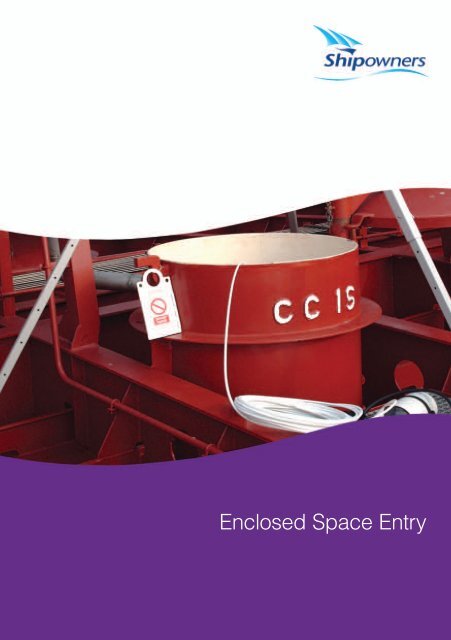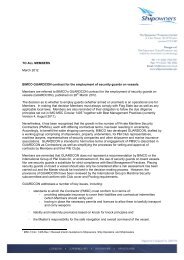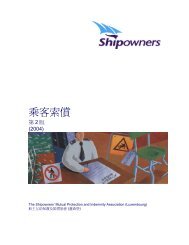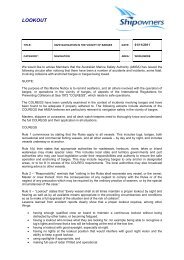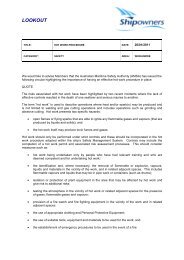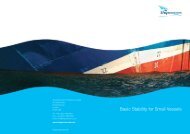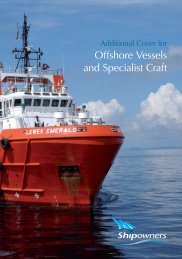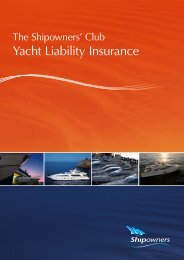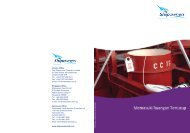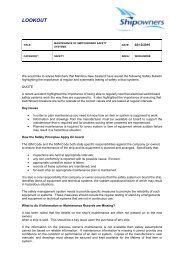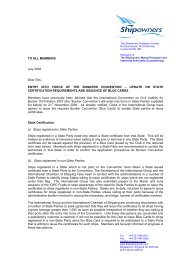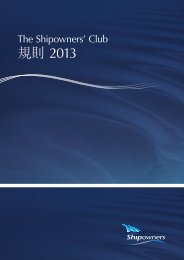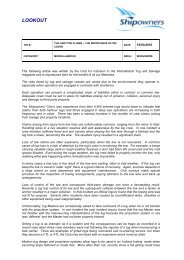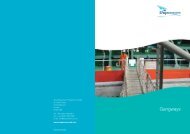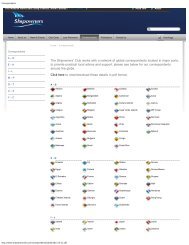Enclosed Space Entry - Shipowners
Enclosed Space Entry - Shipowners
Enclosed Space Entry - Shipowners
You also want an ePaper? Increase the reach of your titles
YUMPU automatically turns print PDFs into web optimized ePapers that Google loves.
<strong>Enclosed</strong> <strong>Space</strong> <strong>Entry</strong>
Contents<br />
2 Introduction<br />
4 <strong>Enclosed</strong> <strong>Space</strong> <strong>Entry</strong> Procedures<br />
– Is the space thoroughly ventilated?<br />
– Has the atmosphere been tested and found safe?<br />
– Is the space prepared for entry?<br />
– Is there sufficient rescue and resuscitation equipment<br />
available at the enclosed space entrance?<br />
– Is there a suitably experienced person in attendance at the entrance?<br />
– Have communication arrangements been agreed<br />
between the person at the entrance and those entering?<br />
– Is there safe access and sufficient illumination?<br />
– What personal protective equipment is to be used?<br />
– Breathing apparatus<br />
– Is a “Permit to Work” in place?<br />
16 Training and <strong>Enclosed</strong> <strong>Entry</strong> Emergency Drills<br />
17 In the Event of an Emergency<br />
18 Acknowledgments<br />
19 Appendices<br />
1
Introduction<br />
The Club has recently experienced a number of claims where people have sadly lost their<br />
lives due to a direct failure to follow correct procedures for enclosed space entry. For the<br />
cases featured within this booklet (Appendix 1) it is important to highlight that the people<br />
involved were qualified and experienced in making enclosed space entries and therefore<br />
trained in the associated dangers, which unfortunately in many circumstances is not the case.<br />
<strong>Enclosed</strong> and confined spaces include, but are not limited to cargo holds, tanks (including<br />
ballast, fore and aft peaks, fresh water, slop / waste and bunker), void spaces, pump rooms,<br />
cofferdams, duct keels, pipe tunnels, main engines, chain lockers and any other spaces<br />
which may normally be kept closed or sealed. This is also relevant to spaces that are not<br />
regularly worked in or have a restricted air flow and hence are not subject to continuous<br />
ventilation.<br />
When seeing a colleague collapsed within an enclosed space it is a natural impulsive reaction<br />
to rush in and assist. Unfortunately this is one of the main causes of fatalities as over 50% of<br />
the workers who die in confined spaces are attempting to rescue other workers who have<br />
found themselves in difficulty. Although this is not the case in the included examples, it is a<br />
common factor and it should be borne in mind that if the correct procedures are followed and<br />
the relevant safety equipment prepared prior to carrying out the entry, then these deaths could<br />
have been avoided.<br />
It is essential to remember that when faced with such a serious dilemma, it is often difficult to<br />
think rationally. Therefore correct preparation resulting from a thorough risk assessment and<br />
evaluation enables the shipboard emergency contingency plans to be implemented in an<br />
expedient fashion.<br />
However, prevention is better than cure. To reduce the possibility of an incident,<br />
notwithstanding the type of vessel or the relevance of the ISM Code, written procedures for<br />
entry into enclosed spaces should be established, therefore giving all persons making an<br />
enclosed space entry instructions to adhere to. Once these procedures have been<br />
implemented, no entries are to be undertaken without compliance.<br />
2
Figure 1: Warning notice displayed on the entrance to an enclosed space<br />
3
<strong>Enclosed</strong> <strong>Space</strong> <strong>Entry</strong> Procedures<br />
The Club has published the following guidelines to assist Members, who do not have their own<br />
procedures, to create their own.<br />
When drafting and developing enclosed space entry procedures reference should also be made to:<br />
4<br />
■ The United Kingdom’s MCA (or home countries equivalent authority) “Code of Safe<br />
Working Practices”, Chapter 17.<br />
■ United Kingdom’s Merchant Shipping (<strong>Entry</strong> Into <strong>Enclosed</strong> <strong>Space</strong>s) Regulation<br />
1988 SI. 1638.<br />
■ IMO Resolution A.864 (20), Recommendations For Entering <strong>Enclosed</strong> <strong>Space</strong>s Aboard<br />
Ships.<br />
■ Local regulations and any official local guidance.<br />
Figure 2: <strong>Entry</strong> tag displayed<br />
on entrance to enclosed<br />
space. This summarises that<br />
the space has been passed<br />
for entry by a competent /<br />
responsible person
Prior to carrying out enclosed space entry, an assessment should be carried out of the<br />
space by a competent person 1 and responsible person 2 . It may be the case on smaller<br />
types of vessels such as barges and vessels operating specifically in and around the<br />
harbour environments, that a competent person and / or the relevant equipment may not<br />
be available onboard. In these cases, no attempt should be made to enter into enclosed<br />
spaces until an appropriate person is present. If the person carrying out the entry is from a<br />
third party e.g. surveyor, the competent person must ensure that they are fully aware of the<br />
vessel’s characteristics or special circumstances which may be a relevant factor to the<br />
safety of the entry.<br />
It should always be borne in mind that everyone has the right to refuse to enter any<br />
compartment that they question the safety of.<br />
Prior to entering an enclosed space a “Permit to Work” system should be in place (see<br />
point 10 – Is a “Permit to Work” in place?). The following are a number of basic checklist<br />
criteria to be used in conjunction with a “Permit to Work” form for entry into enclosed<br />
spaces. All Members, even if entries into enclosed spaces are infrequently carried out<br />
onboard their vessels, should have such a checklist forming part of their laid down<br />
procedures. It should be noted that these recommendations may not be applicable to all<br />
vessels and circumstances but are intended to be used as a guide to demonstrate good<br />
practice from which specific guidelines / procedures can be drawn up.<br />
1 Competent person means a person with sufficient theoretical knowledge and practical experience to make an<br />
informed assessment of the likelihood of a dangerous atmosphere being present or subsequently arising in<br />
the space.<br />
2 Responsible person means a person authorized to permit entry into an enclosed space and having sufficient<br />
knowledge of the procedures to be followed.<br />
Definitions provided by IMO Resolution A.864(20).<br />
5
1) Is the space thoroughly ventilated?<br />
Where possible, prior to the space being entered, all accesses should be opened with at least<br />
one entrance opened at each end of the relevant space. Ventilation should be commenced for<br />
a minimum of 24 hours prior to entry.<br />
Ventilation can be carried out in the following ways, although it is preferable to use mechanical<br />
forms:<br />
a) At sea / in port – This would normally involve natural ventilation unless the vessel is<br />
equipped with portable mechanical blowers or fans. Natural ventilation can be assisted by<br />
using sails or cowls to direct the air flow into the space.<br />
b) At a shipyard – In normal circumstances this would involve forced ventilation using portable<br />
mechanical blowers or fans provided by the shipyard.<br />
It is important to continue ventilation until the enclosed entry is fully completed. If the<br />
ventilation system fails, all persons in the enclosed space must evacuate immediately.<br />
2) Has the atmosphere been tested and found safe?<br />
Before entry, the atmosphere of the space must be tested using suitable instruments. Under<br />
normal circumstances, this would include an Oxygen Analyser and a Combustible Gas Meter<br />
which measures the Lower Explosive Limit (Lower Flammable Limit) of gas in air mixtures.<br />
When particularly toxic cargoes have been carried such as Benzene, specific testing should<br />
be carried out (refer to IMO Resolution A.864 (20) in Appendix 2).<br />
Testing the atmosphere should only be performed by personnel who are fully trained in the<br />
use of the instruments. The manufacturer’s instructions should be strictly adhered to. It is<br />
important to note that the “IMO Resolution A.864 (20), Recommendations For Entering<br />
<strong>Enclosed</strong> <strong>Space</strong>s Aboard Ships” states that for entry purposes, steady readings of 21%<br />
oxygen by volume by oxygen content meter is required. It is often assumed that by deballasting<br />
a tank, a full air change is consequently introduced but this procedure does not<br />
guarantee a safe atmosphere and testing is still required. An empty ballast tank could be<br />
oxygen deficient due to the rusting process in the structure.<br />
6
Combustible gas detectors are not usually designed to measure levels of oxygen as they detect<br />
the amount of flammable gas in air of an inert atmosphere. Ideally, a “multi-meter” should be<br />
used when testing for oxygen, hydrocarbons, carbon monoxide and sulphur dioxide.<br />
The atmosphere analysing equipment should be tested first and calibrated in accordance with<br />
manufacturer’s recommendations. Whilst the enclosed space entry is taking place, oxygen<br />
levels should be regularly tested and where appropriate at different height levels to ensure a<br />
safe environment in all areas. Forced ventilation must be stopped during testing.<br />
Figure 3: Testing the atmosphere of the enclosed space<br />
<strong>Enclosed</strong> space entry procedures<br />
7
3) Is the space prepared for entry?<br />
Prior to operations, the competent person in charge should assess the area for potential<br />
hazards. This can include but not be limited to:<br />
■ Lack of ventilation – see points 1 and 2 of this section.<br />
■ Hazards associated to the nature of the space being entered, e.g. if a cargo space,<br />
what was the last cargo? (see Appendix 2 for IMO Resolution A.864(20),<br />
Recommendations For Entering <strong>Enclosed</strong> <strong>Space</strong>s Aboard Ships). This details the<br />
hazards related to specific types of cargo.<br />
■ Temperature of the enclosed space.<br />
■ Any machinery or working elements that may present a danger to the person entering<br />
the space, such as:<br />
– Valves which may need to be blanked / secured in the closed position; (e.g. lashed<br />
with rope or preferably secured with padlock and chain).<br />
– Warning notices should be posted on controls that operate machinery / equipment in<br />
the relevant space to alert personnel of an ongoing entry (Figures 4 and 5).<br />
Machinery should also be temporarily disabled by removing fuses and breakers in<br />
order to prevent accidental use.<br />
Figures 4 and 5: Warning signs displayed on a valve and at the control station<br />
8
4) Is there sufficient rescue and resuscitation equipment available at the enclosed<br />
space entrance?<br />
If personnel in an enclosed space come into difficulties and require rescue, this has to be<br />
carried out as quickly as possible. Survival times in an oxygen deficient or gaseous<br />
atmosphere is very limited.<br />
In particular, on tankers and other vessels carrying flammable products, all equipment should be<br />
of an approved type (and where necessary certified spark proof) and to speed up a rescue it is<br />
good practice to place the safety equipment at the entrance to the space. This should include:<br />
■ SCBA (Self Contained Breathing Apparatus) with a fully charged spare cylinder.<br />
■ Lifeline and rescue harness. The lifeline should be of an adequate length and strength<br />
and be detachable in case of entanglement.<br />
■ Torches.<br />
■ Stretcher.<br />
■ Gas analysers, oxygen meter.<br />
■ Resuscitation equipment (Figure 6).<br />
■ Means of hoisting up an incapacitated person, e.g. stretcher (Figure 6).<br />
Figure 6: Emergency equipment placed at the entrance to enclosed space<br />
<strong>Enclosed</strong> space entry procedures<br />
9
5) Is there a suitably experienced person in attendance at the entrance?<br />
Both prior to and during the tank inspections it is imperative to ensure that the designated officer<br />
and / or member of the crew stands by at the entrance throughout. In no circumstances should<br />
the person at the access point move from his station until all persons have exited the space.<br />
Figure 7: Designated person in attendance (regular atmosphere tests are taken to ensure a<br />
safe environment)<br />
6) Have communication arrangements been agreed between the person at the entrance<br />
and those entering?<br />
The means of communication between the person(s) entering the tank, the designated crew<br />
member at the access, the Master / allocated competent / responsible person or any relevant<br />
persons in the engine room / bridge should be established prior to entry into the tank and<br />
tested. A pre-arranged frequency / time should be agreed between parties to ensure<br />
communications are maintained.<br />
Communication is to be carried out using appropriate means, e.g. handheld radios of an<br />
approved type (i.e. on tankers intrinsically safe).<br />
10
7) Is there safe access and sufficient illumination?<br />
Sufficient and suitable lighting should be rigged as far as possible and where practical.<br />
All possible accesses should be open to improve ventilation and light. Persons entering an<br />
enclosed space where there is a possibility of a potentially explosive atmosphere should be<br />
equipped with intrinsically safe torches.<br />
8) What personal protective equipment is to be used?<br />
It is important to assess each “enclosed space entry operation” on a case by case basis as<br />
the type of equipment (approved type only) required would be dependent upon the<br />
circumstances at the time.<br />
Basic equipment may include:<br />
■ Hard hat, with chin strap.<br />
■ Gloves.<br />
■ Goggles / protective eyewear.<br />
■ Ear defenders.<br />
■ Intrinsically safe torch.<br />
■ Foot protection.<br />
■ Overalls (protective clothing).<br />
■ An ELSA, EEBD or other emergency escape breathing device.<br />
■ Portable oxygen / gas indicator.<br />
<strong>Enclosed</strong> space entry procedures<br />
The Emergency Escape Breathing Device (EEBD) and emergency escape sets such as an ELSA<br />
(Emergency Life Support Apparatus, see Scott Health & Safety Ltd, www.scottsafety.com) should<br />
not be considered as a SCBA. They are designed to enable escape from a hazardous<br />
environment by providing a limited supply of air delivered via a plastic hood or mask. It should<br />
be borne in mind that these devices must not be used as a means to enable the entry into the<br />
enclosed space as its intended purpose is to enable the user to exit a space safely, should the<br />
atmosphere become oxygen deficient or not gas free.<br />
11
Figure 8: ELSA sets in use<br />
Figure 9: EEBD positioned in the engine room<br />
12
It is advisable for personnel entering the enclosed space to be provided with a portable<br />
oxygen analyser such as the ones manufactured by BW Technologies<br />
(www.gasmonitors.com).<br />
These instruments are designed to be used during an enclosed space entry to continuously<br />
monitor the oxygen content of the atmosphere. If the oxygen level falls below a preset value,<br />
normally 19.5%, a distinct audible, visual and vibration alarm is activated indicating that the<br />
space should be evacuated immediately.<br />
The monitor can be clipped onto the user’s overalls and because it operates passively no<br />
further action is required from the user. If available, this equipment should be utilised<br />
throughout the enclosed space entry.<br />
The instruments should be tested and calibrated on a regular basis in accordance with<br />
manufacturer’s instructions.<br />
Figure 10: Two examples of oxygen / H2S meters<br />
<strong>Enclosed</strong> space entry procedures<br />
If the person entering the tank is using a personal monitoring device it is important that this is<br />
not used to ascertain if the level of oxygen in the space is safe to enter. A separate<br />
independent instrument should be used prior to entry for this purpose.<br />
13
9) Breathing apparatus<br />
I. All crew members should be trained in the use of breathing apparatus (BA). This can be<br />
ensured by performing regular safety drills and including it in the onboard training<br />
procedures. When the responsible person is allocating personnel for the entry, the<br />
proficiency of using equipment should be taken into account. This may mean having a<br />
designated emergency team trained fully in the use of relevant equipment to respond to this<br />
type of emergency.<br />
II. To ensure the efficient operation of the apparatus, they must be tested regularly.<br />
10) Is a “Permit to Work” in place?<br />
A “Permit to Work” should be completed for each and every enclosed space entry as it serves<br />
as both a check and a record that all necessary measures have been properly carried out and<br />
are in place for the intended enclosed space entry. When completing the form the responsible<br />
person should allocate a time period for which the permit is valid, this should never exceed 24<br />
hours. A copy of the permit must be placed outside the entry point. On expiry of the permit all<br />
persons should leave the space and re-entry should not be made until another permit has<br />
been issued.<br />
The points below detail general precautions that the “Permit to Work” should cover and which<br />
have also been highlighted previously (see Appendix 3 for an example of a “Permit to Work”<br />
system). Additional points may be added specific to the space being entered as required:<br />
14<br />
■ Location, type of work, details of participating crew, competent person in charge,<br />
validity period of the permit and authorising officer.<br />
■ <strong>Space</strong> ventilated and the confirmation that continuous ventilation is in progress.<br />
■ <strong>Enclosed</strong> space atmosphere tested.<br />
■ Potential hazards identified and isolated as appropriate.<br />
■ Rescue and resuscitation equipment positioned in case of emergency<br />
(It should be borne in mind that when using breathing apparatus in stressful<br />
emergency situations, the users air consumption is greatly increased and the duration<br />
of available air is thus decreased).
■ Testing of the equipment, confirmation they are of an approved type and that relevant<br />
persons are competent in their use (e.g. breathing apparatus).<br />
■ <strong>Space</strong> and access illuminated as far as possible.<br />
■ Suitable communication system set up between all involved parties.<br />
■ Designated person positioned at the access.<br />
■ All involved persons are wearing correct personal safety equipment of approved types.<br />
■ Permit to work has been completed and signed by all appropriate parties concerned.<br />
Figure 11: Safety notice from IMO Resolution A.864(20) - 199<br />
<strong>Enclosed</strong> space entry procedures<br />
15
Training and <strong>Enclosed</strong> <strong>Entry</strong> Emergency Drills<br />
In addition to drills that are carried out to tackle enclosed space entry in an emergency,<br />
training should be provided to crew members on identifying the applicable spaces and their<br />
associated problems, including the nature of activities, which may cause an unsafe<br />
atmosphere to be present.<br />
Emergency drills should be conducted on a regular basis to familiarise the entire vessel’s<br />
compliment with the procedures and measures required for an enclosed space entry rescue.<br />
These drills should be carried out as frequently as possible and particularly onboard vessels<br />
for which enclosed space entry is not a regular occurrence. It is important to remember that<br />
each vessel may have its own problems or characteristics which may affect the rescue<br />
operation and therefore all procedures must be vessel specific.<br />
Figure 12: <strong>Enclosed</strong> space drill and training in progress to familiarise crew members with<br />
associated equipment<br />
16
These drills will assist in testing pre-defined contingency plans for feasibility and to ascertain<br />
how they fare with different scenarios. They should be made as realistic as possible by using<br />
appropriate spaces where such incidents are likely to occur. For added effect, a dummy of<br />
realistic weight and size should be used as a victim. All drills must be recorded in the vessel’s<br />
official log book along with any noted comments.<br />
Various industry publications are available to assist with enclosed entry training such as<br />
Walport’s “<strong>Enclosed</strong> <strong>Space</strong> <strong>Entry</strong> – Safe <strong>Entry</strong> Procedures” (www.walport.co.uk) and Seamanship<br />
International’s “Seamanship Training 2006” (www.witherbyseamanship.com).<br />
In the Event of an Emergency<br />
In the event of an emergency the vessel’s crew must follow the emergency procedures set down<br />
on how to respond to the current situation. The following illustrates some areas to be covered<br />
by the vessel’s emergency plans, but it should be noted that this is not exhaustive:<br />
■ The composition and duties of the persons acting within the emergency plan, e.g. the<br />
designated person at the entrance to the space entered must remain in place and not be<br />
tempted to enter the space when it is apparent an emergency situation is developing.<br />
■ Procedures for the assignment of duties for the emergency teams.<br />
■ Procedures for communication between all parties concerned.<br />
■ The availability of the equipment required including the vessel’s plans and relevant<br />
equipment.<br />
■ Checklists have been set up to assist the personnel on site to cover all aspects which<br />
may be missed in the heat of the moment but are an important factor.<br />
■ The manner in which the vessel liaises with third parties including shore management,<br />
shore authorities and the media.<br />
17
Acknowledgments<br />
BW TECHNOLOGIES<br />
BW Technologies by Honeywell<br />
5 Canada Close<br />
Banbury OX16 2RT<br />
Email: bwesales@gasmonitors.com<br />
Website: www.gasmonitors.com<br />
IACS<br />
IACS “Confined <strong>Space</strong> Safe Practice” document.<br />
IMO<br />
IMO Resolution A.864(20), Adopted on 27th<br />
November 1997 (Agenda item 9) –<br />
Recommendations For Entering <strong>Enclosed</strong> <strong>Space</strong>s<br />
Aboard Ships.<br />
MARINE ACCIDENT INVESTIGATION<br />
BRANCH (MAIB)<br />
Website: www.maib.gov.uk<br />
MCA<br />
Code of Safe Working Practices, chapter 17 -<br />
www.mcga.gov.uk/c4mca/coswop-2.pdf<br />
The Merchant Shipping (<strong>Entry</strong> into dangerous<br />
spaces) regulation 1988 SI 1638<br />
WITHERBY SEAMANSHIP<br />
INTERNATIONAL LTD<br />
4 Dunlop Square<br />
Deans Estate<br />
Livingston EH54 8SB<br />
Tel: + 44 (0) 1506 463 227<br />
Fax: + 44 (0) 1506 468 999<br />
Email: info@emailws.com<br />
Website: www.witherbyseamanship.com<br />
18<br />
SCOTT HEALTH & SAFETY LTD<br />
Pimbo Road<br />
West Pimbo<br />
Skelmersdale<br />
Lancashire WN8 9RA<br />
United Kingdom<br />
Tel: + 44 1695 711711<br />
Fax: + 44 1695 711772<br />
Email: scottint.uk@tycoint.com<br />
Website: www.scottsafety.com<br />
SPECTRA MARITIME & SURVEYS PTE LTD<br />
48 MacTaggart Road, #07-03<br />
MAE Industrial Building<br />
Singapore 368088<br />
Tel: +65 6221 5458<br />
Fax: +65 6224 7442<br />
Group email: office@spectra-mc.com<br />
TRANSPORT CANADA<br />
Website: www.tc.gc.ca/marine/menu.htm<br />
WALPORT INTERNATIONAL LTD<br />
Alma House<br />
Alma Road<br />
Reigate<br />
Surrey RH2 0AX<br />
Tel +44(0)1737 229 590<br />
Email: sales@walport.co.uk<br />
Website: www.walport.co.uk
Appendix 1 The following case studies have been issued by the MAIB<br />
Case Study 1<br />
A 12,000 gross registered tonnage foreign flagged Ro-Ro cargo vessel, operated by British<br />
Officers, was on passage to the UK. The vessel's fuel oil was found to contain water and<br />
during the search to find the cause, tanks were opened and inspected. The Chief Engineer<br />
carrying out the inspection was found by a watchkeeper with his legs protruding out of a tank<br />
manhole. He was removed from the tank and First Aid was carried out immediately, but<br />
without success. The pathologist who carried out the post mortem, confirmed the cause of<br />
death was due to lack of oxygen and exposure to oil fumes.<br />
Observations<br />
1. No forced ventilation of the tanks was used.<br />
2. No test on the tank atmosphere was made, as the oxygen meter's battery was flat.<br />
3. No other person was in attendance at the tank entrance.<br />
4. Breathing apparatus was not made available.<br />
Comment<br />
1. There have been many similar accidents, one was reported in the MAIB Summary of<br />
Investigations 3/93 publication, page 2. For those who have not seen the guidance<br />
regarding safe entry into spaces it is contained in the following:<br />
– The “Code of Safe Working Practices for Merchant Seamen1 ” (1991 Edition),<br />
Chapter 10 – Entering <strong>Enclosed</strong> or Confined <strong>Space</strong>s;<br />
– A MARITIME SAFETY CARD published by the International Maritime Organization which<br />
sets out basic precautions on tank entry and provides a safety check list.<br />
2. It is disturbing that officers who should be aware of the requirements for safe entry to<br />
spaces do not carry out basic checks and take the necessary precautions.<br />
3. For UK vessels the legislation contained in the Merchant Shipping (<strong>Entry</strong> into Dangerous<br />
<strong>Space</strong>s) Regulations 1988 as amended, would apply.<br />
1 Please note that since this case study has been published, the information on ‘Entering <strong>Enclosed</strong> or Confined <strong>Space</strong>s’ can now<br />
be found in Chapter 17 of the 2004 consolidated version of the ‘Code of Safe Working Practices for Merchant Seaman’<br />
19
Case Study 2<br />
A small coaster was at anchor off the south coast of England sheltering from severe weather<br />
conditions. Loaded with a cargo of coal, her hold was fitted with a moveable bulkhead, the<br />
position of which was dependent on the quantity being carried. For this consignment it was set<br />
about 3 metres forward of the engine bulkhead. The access hatch, fitted with a vertical ladder,<br />
opened into the space between the engine room bulkhead and the moveable bulkhead. The<br />
only ventilation into this space was that provided naturally through the access hatch.<br />
The master was on the bridge on the morning after anchoring, but it wasn't until that evening<br />
that anyone realised he hadn't been seen all day. The chief officer noticed the cargo hold<br />
access hatch was open and, on looking into the hold, saw the master lying at the bottom.<br />
The local authorities were called and the master was removed. He was found to be dead, with<br />
the cause of death later determined to be asphyxiation. The oxygen level in the hold was less<br />
than 3.5% and carbon monoxide, together with higher than normal levels of carbon dioxide,<br />
were also present.<br />
The Lessons<br />
1. Anyone who has been at sea for some time in merchant ships will be all too familiar with<br />
stories of people who have entered enclosed spaces without taking the necessary<br />
precautions, and died as the result. The lessons from such incidents have been hammered<br />
home time and time again and still it happens. Although it is impossible to know exactly<br />
what victims are thinking before they make an entry, it is feasible to assume they think the<br />
space is sufficiently safe to warrant entry. After all, it looks all right, so what could possibly<br />
go wrong?<br />
2. Some spaces are evidently dangerous, and there are very sound rules in place to prevent<br />
accidents. Consult the IMDG code to know the properties and characteristics of dangerous<br />
bulk cargoes before entering a space where such cargo is being, or has been carried.<br />
Follow the excellent advice in Chapter 17 of the Code of Safe Working Practices for<br />
20
Appendices<br />
Merchant Seamen, which documents the procedures for entering enclosed spaces. The<br />
main points are: the space must always be tested before and during each entry,<br />
personnel should be standing by with safety equipment at the entrance, and the space<br />
should be well ventilated.<br />
3. Other spaces are not necessarily quite so obvious. They include void spaces not normally<br />
entered, compartments that might have been flooded, or areas separated from dangerous<br />
cargo by a portable bulkhead. If in doubt, assume the space is potentially dangerous and<br />
take the necessary precautions. Remember 3.5% of oxygen looks exactly the same as the<br />
18% 1 which is the minimum required for human beings to breathe safely. Anything below<br />
that can lead to loss of life.<br />
4. Never ever carry out an entry alone. A well-formulated plan should always be followed. A<br />
short-cut could prove fatal.<br />
5. And one final point. If you see someone lying motionless at the bottom of a ladder in an<br />
enclosed space, don't rush in to carry out a rescue without taking all the appropriate<br />
precautions. Failure to do so will only result in more fatalities.<br />
1Reference should be made to IMO Resolution A.864 (20) Section 6 “Testing the Atmosphere”<br />
where it states for entry purposes 21% oxygen by volume is required.<br />
21
Case Study 3<br />
A single-hold general cargo vessel of 996 gross registered tonnage was alongside in port and<br />
had commenced discharging her cargo of timber. The timber consisted of approximately 3<br />
metre length cut hard wood logs of up to 30cm in diameter with bark attached. The logs were<br />
loaded inside the cargo hold up to the level of the hatch coaming and also as deck cargo on<br />
top of the closed hatch covers.<br />
Prior to opening the hatch covers, it was normal practice for the crew to sweep up any<br />
remaining debris on top of the hatch covers upon completion of the deck cargo discharge.<br />
In preparation for this task, the Mate instructed one of his crew to fetch some brooms, which<br />
were stored both in the forward storerooms and also at the bottom of the cargo hold aft<br />
access trunkway.<br />
A few minutes later, the attention of the Mate was drawn to the crew member, who was now<br />
lying at the bottom of the aft access trunkway. While assistance was being summoned, the<br />
Mate entered the trunkway and was subsequently found lying on top of the first crew member.<br />
Another crew member entered the trunkway but, after experiencing difficulty in breathing,<br />
climbed back out. A shore worker then attempted to enter the trunkway but was prevented<br />
from doing so by another member of the crew.<br />
After being alerted to the emergency, the Master started the cargo hold fan and then entered<br />
the trunkway wearing a self-contained breathing apparatus set. Both men were removed from<br />
the trunkway using a block and tackle but subsequent attempts to revive them failed.<br />
Observations<br />
1. The cargo hold and access trunkways had not been ventilated since the logs were loaded<br />
approximately 6 days before the accident.<br />
2. Although the vessel carried gas detection equipment, no means were provided for remote<br />
detection.<br />
3. Brooms were stored at the bottom of the trunkway for the purpose of sweeping the cargo<br />
hold upon completion of discharge.<br />
22
Appendices<br />
4. In order to confirm the probable condition of the atmosphere inside the trunkway at the<br />
time of the accident, atmospheric tests were conducted under similar conditions upon the<br />
vessel’s next arrival at the port. The test results included a minimum oxygen reading of<br />
1.9% and a maximum carbon dioxide reading of 10.5%.<br />
Comments<br />
1. The two men died when they entered a dangerous enclosed space, which was deficient in<br />
oxygen and contained gas products of the timber cargo.<br />
2. The Merchant Shipping (<strong>Entry</strong> into Dangerous <strong>Space</strong>s) Regulations 1988 (as amended)<br />
apply to UK vessels and to non-UK vessels when in a UK port. They require that entrances to<br />
unattended dangerous spaces should be secured against entry and that procedures for safe<br />
entry should be laid down and enforced. A conscientious regard for the training of crew and<br />
for the strict enforcement of clearly understood procedures would probably have prevented<br />
this accident.<br />
3. Although it is generally known that a depletion of oxygen may occur in cargo spaces filled<br />
with certain types of wood cargoes, the danger associated with the carriage of logs requires<br />
increased attention.<br />
23
Appendix 2<br />
IMO Resolution A.864 (20), Recommendations For Entering <strong>Enclosed</strong> <strong>Space</strong>s Aboard<br />
Ships. Adopted on 27 November 1997.<br />
1 INTRODUCTION<br />
The atmosphere in any enclosed space may be deficient in oxygen and/or contain flammable<br />
and/or toxic gases or vapours. Such an unsafe atmosphere could also subsequently occur in<br />
a space previously found to be safe. Unsafe atmosphere may also be present in spaces<br />
adjacent to those spaces where a hazard is known to be present.<br />
2 DEFINITIONS<br />
2.1 <strong>Enclosed</strong> space means a space which has any of the following characteristics:<br />
.1 limited openings for entry and exit;<br />
.2 unfavourable natural ventilation; and<br />
.3 is not designed for continuous worker occupancy,<br />
and includes, but is not limited to, cargo spaces, double bottoms, fuel tanks, ballast tanks,<br />
pump-rooms, compressor rooms, cofferdams, void spaces, duct keels, inter-barrier<br />
spaces, engine crankcases and sewage tanks.<br />
2.2 Competent person means a person with sufficient theoretical knowledge and practical<br />
experience to make an informed assessment of the likelihood of a dangerous atmosphere<br />
being present or subsequently arising in the space.<br />
2.3 Responsible person means a person authorized to permit entry into an enclosed space<br />
and having sufficient knowledge of the procedures to be followed.<br />
3 ASSESSMENT OF RISK<br />
3.1 In order to ensure safety, a competent person should always make a preliminary<br />
assessment of any potential hazards in the space to be entered, taking into account<br />
previous cargo carried, ventilation of the space, coating of the space and other relevant<br />
factors. The competent person's preliminary assessment should determine the potential<br />
for the presence of an oxygen-deficient, flammable or toxic atmosphere.<br />
24
Appendices<br />
3.2 The procedures to be followed for testing the atmosphere in the space and for entry<br />
should be decided on the basis of the preliminary assessment. These will depend on<br />
whether the preliminary assessment shows that:<br />
.1 there is minimal risk to the health or life of personnel entering the space;<br />
.2 there is no immediate risk to health or life but a risk could arise during the course of<br />
work in the space; and<br />
.3 a risk to health or life is identified.<br />
3.3 Where the preliminary assessment indicates minimal risk to health or life or potential for a<br />
risk to arise during the course of work in the space, the precautions described in 4, 5, 6<br />
and 7 should be followed as appropriate.<br />
3.4 Where the preliminary assessment identifies risk to life or health, if entry is to be made, the<br />
additional precautions specified in section 8 should also be followed.<br />
4 AUTHORIZATION OF ENTRY<br />
4.1 No person should open or enter an enclosed space unless authorized by the master or<br />
nominated responsible person and unless the appropriate safety procedures laid down for<br />
the particular ship have been followed.<br />
4.2 <strong>Entry</strong> into enclosed spaces should be planned and the use of an entry permit system,<br />
which may include the use of a checklist, is recommended. An <strong>Enclosed</strong> <strong>Space</strong> <strong>Entry</strong><br />
Permit should be issued by the master or nominated responsible person, and completed<br />
by a person who enters the space prior to entry. An example of the <strong>Enclosed</strong> <strong>Space</strong> <strong>Entry</strong><br />
Permit is provided in the appendix.<br />
25
5 GENERAL PRECAUTIONS<br />
5.1 The master or responsible person should determine that it is safe to enter an enclosed<br />
space by ensuring:<br />
.1 that potential hazards have been identified in the assessment and as far as possible<br />
isolated or made safe;<br />
.2 that the space has been thoroughly ventilated by natural or mechanical means to<br />
remove any toxic or flammable gases, and to ensure an adequate level of oxygen<br />
throughout the space;<br />
.3 that the atmosphere of the space has been tested as appropriate with properly<br />
calibrated instruments to ascertain acceptable levels of oxygen and acceptable levels<br />
of flammable or toxic vapours;<br />
.4 that the space has been secured for entry and properly illuminated;<br />
.5 that a suitable system of communication between all parties for use during entry has<br />
been agreed and tested;<br />
.6 that an attendant has been instructed to remain at the entrance to the space whilst it<br />
is occupied;<br />
.7 that rescue and resuscitation equipment has been positioned ready for use at the<br />
entrance to the space, and that rescue arrangements have been agreed;<br />
.8 that personnel are properly clothed and equipped for the entry and subsequent tasks;<br />
and<br />
.9 that a permit has been issued authorizing entry.<br />
26<br />
The precautions in .6 and .7 may not apply to every situation described in this section.<br />
The person authorizing entry should determine whether an attendant and the positioning<br />
of rescue equipment at the entrance to the space is necessary.<br />
5.2 Only trained personnel should be assigned the duties of entering, functioning as<br />
attendants, or functioning as members of rescue teams. Ships' crews should be drilled<br />
periodically in rescue and first aid.<br />
5.3 All equipment used in connection with entry should be in good working condition and<br />
inspected prior to use.
Appendices<br />
6 TESTING THE ATMOSPHERE<br />
6.1 Appropriate testing of the atmosphere of a space should be carried out with properly<br />
calibrated equipment by persons trained in the use of the equipment. The manufacturers'<br />
instructions should be strictly followed. Testing should be carried out before any person<br />
enters the space, and at regular intervals thereafter until all work is completed. Where<br />
appropriate, the testing of the space should be carried out at as many different levels as<br />
is necessary to obtain a representative sample of the atmosphere in the space.<br />
6.2 For entry purposes, steady readings of the following should be obtained:<br />
.1 21% oxygen by volume by oxygen content meter; and<br />
.2 not more than 1% of lower flammable limit (LFL) on a suitably sensitive combustible<br />
gas indicator, where the preliminary assessment has determined that there is potential<br />
for flammable gases or vapours.<br />
If these conditions cannot be met, additional ventilation should be applied to the space and<br />
re-testing should be conducted after a suitable interval. Any gas testing should be carried<br />
out with ventilation to the enclosed space stopped, in order to obtain accurate readings.<br />
6.3 Where the preliminary assessment has determined that there is potential for the presence<br />
of toxic gases and vapours, appropriate testing should be carried out using fixed or<br />
portable gas or vapour detection equipment. The readings obtained by this equipment<br />
should be below the occupational exposure limits for the toxic gases or vapours given in<br />
accepted national or international standards. It should be noted that testing for<br />
flammability does not provide a suitable means of measuring for toxicity, nor vice versa.<br />
6.4 It should be emphasized that pockets of gas or oxygen-deficient areas can exist, and<br />
should always be suspected, even when an enclosed space has been satisfactorily tested<br />
as being suitable for entry.<br />
27
7 PRECAUTIONS DURING ENTRY<br />
7.1 The atmosphere should be tested frequently whilst the space is occupied, and persons<br />
should be instructed to leave the space should there be a deterioration in the conditions.<br />
7.2 Ventilation should continue during the period that the space is occupied and during<br />
temporary breaks. Before re-entry after a break, the atmosphere should be re-tested. In the<br />
event of failure of the ventilation system, any persons in the space should leave immediately.<br />
7.3 In the event of an emergency, under no circumstances should the attending crew member<br />
enter the space before help has arrived and the situation has been evaluated to ensure the<br />
safety of those entering the space to undertake rescue operations.<br />
8 ADDITIONAL PRECAUTIONS FOR ENTRY INTO A SPACE WHERE THE ATMOSPHERE<br />
IS KNOWN OR SUSPECTED TO BE UNSAFE<br />
8.1 If the atmosphere in an enclosed space is suspected or known to be unsafe, the space<br />
should only be entered when no practical alternative exists. <strong>Entry</strong> should only be made for<br />
further testing, essential operation, safety of life or safety of a ship. The number of persons<br />
entering the space should be the minimum compatible with the work to be performed.<br />
8.2 Suitable breathing apparatus, e.g. of the air-line or self-contained type, should always be<br />
worn, and only personnel trained in its use should be allowed to enter the space. Air-purifying<br />
respirators should not be used as they do not provide a supply of clean air from a source<br />
independent of the atmosphere within the space.<br />
8.3 The precautions specified in 5 should also be followed, as appropriate.<br />
8.4 Rescue harnesses should be worn and, unless impractical, lifelines should be used.<br />
8.5 Appropriate protective clothing should be worn particularly where there is any risk of<br />
toxic substances or chemicals coming into contact with the skin or eyes of those entering<br />
the space.<br />
8.6 The advice in 7.3 concerning emergency rescue operations is particularly relevant in this<br />
context.<br />
28
9 HAZARDS RELATED TO SPECIFIC TYPES OF CARGO<br />
9.1 Dangerous goods in packaged form<br />
Appendices<br />
9.1.1 The atmosphere of any space containing dangerous goods may put at risk the health<br />
or life of any person entering it. Dangers may include flammable, toxic or corrosive<br />
gases or vapours that displace oxygen, residues on packages and spilled material.<br />
The same hazards may be present in spaces adjacent to the cargo spaces.<br />
Information on the hazards of specific substances is contained in the IMDG Code, the<br />
Emergency Procedures for Ships Carrying Dangerous Goods (EmS) and Materials<br />
Safety Data Sheets (MSDS). If there is evidence or suspicion that leakage of<br />
dangerous substances has occurred, the precautions specified in 8 should be<br />
followed.<br />
9.1.2 Personnel required to deal with spillages or to remove defective or damaged<br />
packages should be appropriately trained and wear suitable breathing apparatus and<br />
appropriate protective clothing.<br />
9.2 Bulk liquid<br />
The tanker industry has produced extensive advice to operators and crews of ships<br />
engaged in the bulk carriage of oil, chemicals and liquefied gases, in the form of<br />
specialist international safety guides. Information in the guides on enclosed space entry<br />
amplifies these recommendations and should be used as the basis for preparing entry<br />
plans.<br />
9.3 Solid bulk<br />
On ships carrying solid bulk cargoes, dangerous atmospheres may develop in cargo<br />
spaces and adjacent spaces. The dangers may include flammability, toxicity, oxygen<br />
depletion or self-heating, which should be identified in shipping documentation. For<br />
additional information, reference should be made to the Code of Safe Practice for Solid<br />
Bulk Cargoes.<br />
29
9.4 Oxygen-depleting cargoes and materials<br />
A prominent risk with such cargoes is oxygen depletion due to the inherent form of the<br />
cargo, for example, self-heating, oxidation of metals and ores or decomposition of<br />
vegetable oils, animal fats, grain and other organic materials or their residues. The<br />
materials listed below are known to be capable of causing oxygen depletion. However, the<br />
list is not exhaustive. Oxygen depletion may also be caused by other materials of<br />
vegetable or animal origin, by flammable or spontaneously combustible materials, and by<br />
materials with a high metal content:<br />
.1 grain, grain products and residues from grain processing (such as bran, crushed<br />
grain, crushed malt or meal), hops, malt husks and spent malt;<br />
.2 oilseeds as well as products and residues from oilseeds (such as seed expellers,<br />
seed cake, oil cake and meal);<br />
.3 copra;<br />
.4 wood in such forms as packaged timber, roundwood, logs, pulpwood, props (pit<br />
props and other propwood), woodchips, woodshavings, woodpulp pellets and<br />
sawdust;<br />
.5 jute, hemp, flax, sisal, kapok, cotton and other vegetable fibres (such as esparto<br />
grass/Spanish grass, hay, straw, bhusa), empty bags, cotton waste, animal fibres,<br />
animal and vegetable fabric, wool waste and rags;<br />
.6 fishmeal and fishscrap;<br />
.7 guano;<br />
.8 sulphidic ores and ore concentrates;<br />
.9 charcoal, coal and coal products;<br />
.10 direct reduced iron (DRI);<br />
.11 dry ice;<br />
.12 metal wastes and chips, iron swarf, steel and other turnings, borings, drillings,<br />
shavings, filings and cuttings; and<br />
.13 scrap metal.<br />
30
Appendices<br />
9.5 Fumigation<br />
When a ship is fumigated, the detailed recommendations contained in the<br />
Recommendations on the safe use of pesticides in ships* should be followed. <strong>Space</strong>s<br />
adjacent to fumigated spaces should be treated as if fumigated.<br />
CONCLUSION<br />
Failure to observe simple procedures can lead to people being unexpectedly overcome when<br />
entering enclosed spaces. Observance of the principles outlined above will form a reliable<br />
basis for assessing risks in such spaces and for taking necessary precautions.<br />
31
Appendix 3<br />
Example of an <strong>Enclosed</strong> <strong>Space</strong> <strong>Entry</strong> Permit taken from The IMO Resolution A.864 (20),<br />
Recommendations For Entering <strong>Enclosed</strong> <strong>Space</strong>s Aboard Ships. Adopted on 27 November 1997.<br />
Example of an <strong>Enclosed</strong> <strong>Space</strong> <strong>Entry</strong> Permit<br />
This permit relates to entry into any enclosed space and should be completed by the master or<br />
responsible officer and by the person entering the space or authorized team leader.<br />
General<br />
Location/name of enclosed space<br />
Reason for entry<br />
This permit is valid from: hrs Date<br />
to: hrs Date<br />
(See note 1)<br />
Section 1 – Pre-entry preparation<br />
(To be checked by the master or nominated responsible person)<br />
■ Has the space been thoroughly ventilated?<br />
■ Has the space been segregated by blanking off or isolating all<br />
connecting pipelines or valves and electrical power/equipment?<br />
■ Has the space been cleaned where necessary?<br />
■ Has the space been tested and found safe for entry? (See note 2)<br />
■ Pre-entry atmosphere test readings:<br />
Yes No<br />
– oxygen % vol (21%) By:<br />
– hydrocarbon % LFL (less than 1%)<br />
– toxic gases ppm (specific gas and PEL) Time:<br />
(See note 3)<br />
■ Have arrangements been made for frequent atmosphere checks to<br />
be made while the space is occupied and after work breaks?<br />
■ Have arrangements been made for the space to be continuously<br />
ventilated throughout the period of occupation and during work breaks?<br />
■ Are access and illumination adequate?<br />
32
■ Is rescue and resuscitation equipment available<br />
for immediate use by the entrance to the space?<br />
■ Has a responsible person been designated to be in<br />
constant attendance at the entrance to the space?<br />
■ Has the officer of the watch (bridge, engine-room, cargo<br />
control room) been advised of the planned entry?<br />
■ Has a system of communication between all parties<br />
been tested and emergency signals agreed?<br />
■ Are emergency and evacuation procedures established and<br />
understood by all personnel involved with the enclosed space entry?<br />
■ Is all equipment used in good working condition<br />
and inspected prior to entry?<br />
■ Are personnel properly clothed and equipped?<br />
Appendices<br />
Yes No<br />
Section 2 – Pre-entry checks<br />
(To be checked by the person entering the space or authorized team leader)<br />
■ I have received instructions or permission from the master or<br />
nominated responsible person to enter the enclosed space<br />
■ Section 1 of this permit has been satisfactorily<br />
completed by the master or nominated responsible person<br />
■ I have agreed and understand the communication procedures<br />
Yes No<br />
■ I have agreed upon a reporting interval of<br />
■ Emergency and evacuation procedures have<br />
been agreed and are understood<br />
minutes<br />
■ I am aware that the space must be vacated immediately<br />
in the event of ventilation failure or if atmosphere tests<br />
show a change from agreed safe criteria<br />
33
Section 3 – Breathing apparatus and other equipment<br />
(To be checked jointly by the master or nominated responsible person<br />
and the person who is to enter the space)<br />
■ Those entering the space are familiar with the<br />
breathing apparatus to be used<br />
■ The breathing apparatus has been tested as follows:<br />
– gauge and capacity of air supply<br />
– low pressure audible alarm<br />
– face mask – under positive pressure and not leaking<br />
■ The means of communication has been tested and<br />
emergency signals agreed<br />
■ All personnel entering the space have been provided<br />
with rescue harnesses and, where practicable, lifelines<br />
Signed upon completion of sections 1, 2 and 3 by:<br />
Master or nominated responsible person Date Time<br />
Responsible person supervising entry Date Time<br />
Person entering the space or<br />
authorized team leader Date Time<br />
Section 4 – Personnel entry<br />
(To be completed by the responsible person supervising entry)<br />
Names Time in Time out<br />
34<br />
Yes No
Section 5 – Completion of job<br />
(To be completed by the responsible person supervising entry)<br />
■ Job completed Date Time<br />
■ <strong>Space</strong> secured against entry Date Time<br />
■ The officer of the watch has been duly informed Date Time<br />
Signed upon completion of sections 4 and 5 by:<br />
Responsible person supervising entry Date Time<br />
THIS PERMIT IS RENDERED INVALID SHOULD VENTILATION OF THE SPACE STOP OR IF<br />
ANY OF THE CONDITIONS NOTED IN THE CHECKLIST CHANGE<br />
Notes:<br />
1 The permit should contain a clear indication as to its maximum period of validity.<br />
Appendices<br />
2 In order to obtain a representative cross-section of the space’s atmosphere, samples<br />
should be taken from several levels and through as many openings as possible.<br />
Ventilation should be stopped for about 10 minutes before the pre-entry atmosphere tests<br />
are taken.<br />
3 Tests for specific toxic contaminants, such as benzene or hydrogen sulphide, should be<br />
undertaken depending on the nature of the previous contents of the space.<br />
35
Notes<br />
36
The <strong>Shipowners</strong>’ Protection Limited<br />
St Clare House<br />
30-33 Minories<br />
London<br />
EC3N 1BP<br />
Tel: +44 (0)20 7488 0911<br />
Fax: +44 (0)20 7480 5806<br />
Email: info@shipowners.co.uk<br />
www.shipownersclub.com<br />
Published December 2007


